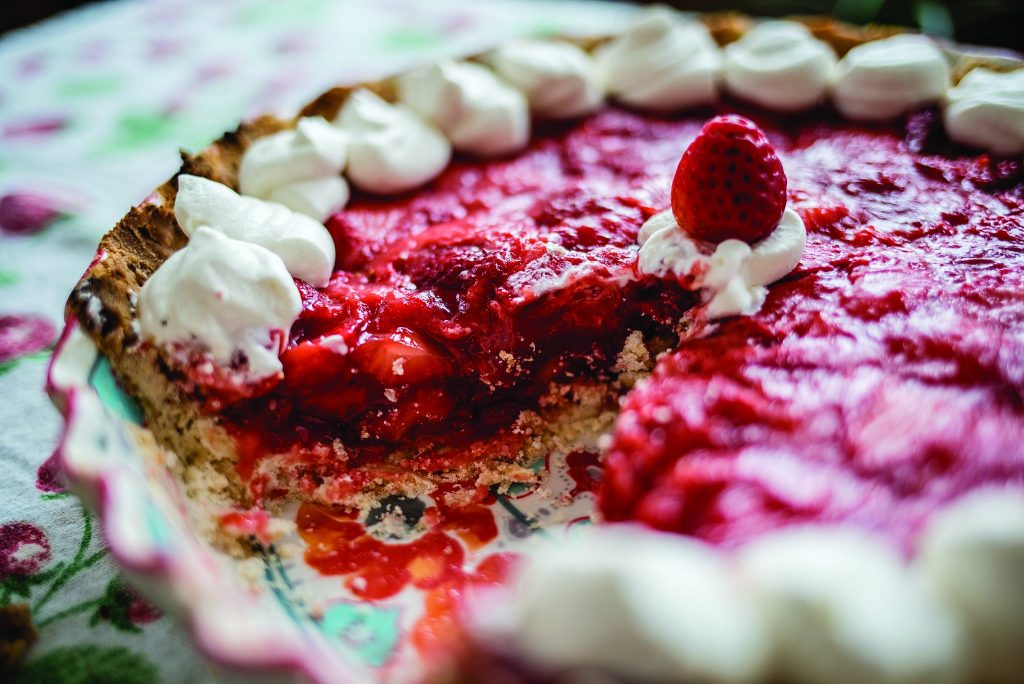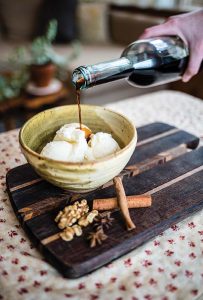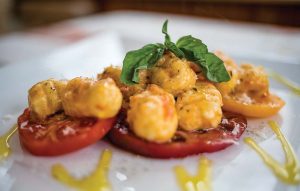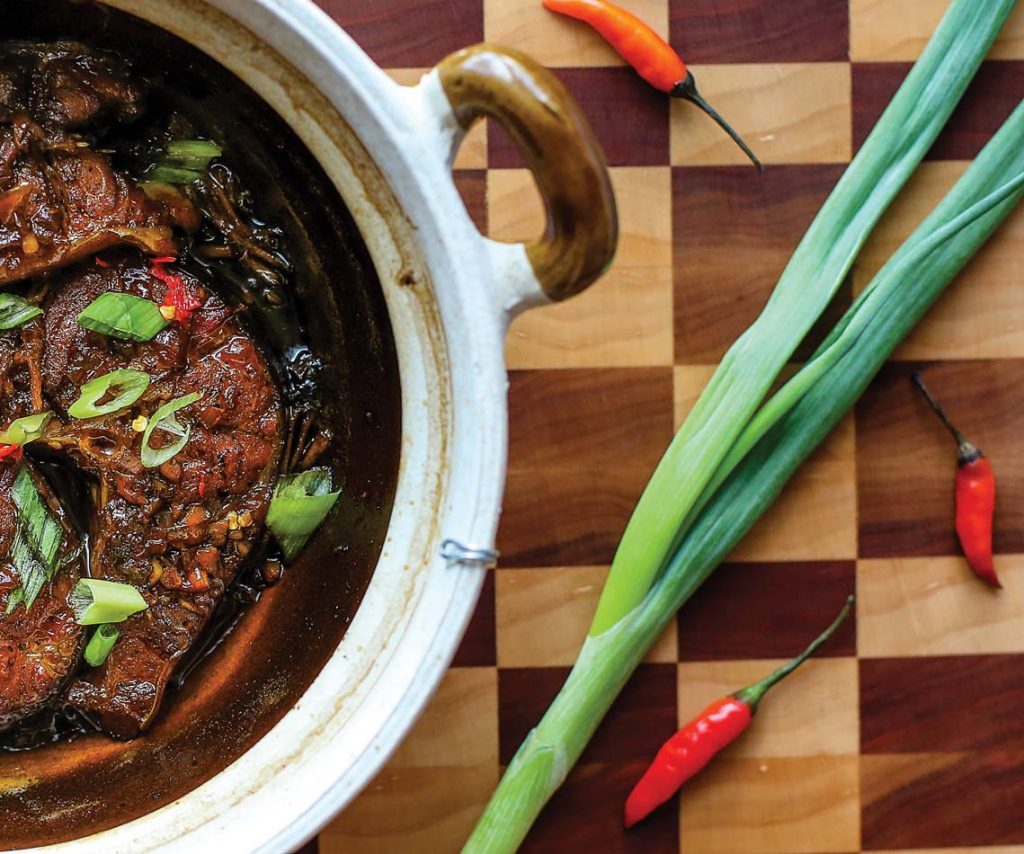Enlarge

By Ryan Sparks
Summer gives full credence to Nebraska’s state slogan “the good life.” Long days of sunshine and an explosion of green are proof that muddling through winter was worth it. Wild plums adorn field edges, summer breezes stir the corn into a swaying dance and sun tea steeps on porches across the state. At no other time do the flavors of Nebraska present themselves more readily, and nowhere are they more abundant than a Nebraska garden. These gardens are magical places and the dishes of the Nebraska table reflect their bounty.
Nebraska has a long-standing gardening heritage. Seed catalogs from Lincoln dating back to the 1880s advertise radishes, peas and “early red perfection” tomatoes. Nebraska gardeners persevered through the Dust Bowl, famines and stock market crashes. During World War II, “Victory Gardens” grew bumper crops for the war effort, and gardeners from Omaha to Scottsbluff helped ease the food shortage. Today, many Nebraskans continue this tradition, planting the same varieties enjoyed throughout the state for more than a century. Across Nebraska, gardeners work to bring their harvest to the table. They prepare the soil, pluck stubborn weeds and nurture tender green shoots into delicious fruits and vegetables. While each gardener has their own reason for cultivating plant life – pleasure, nourishment, mental calm – the results are nearly the same: fresh-from-the-vine tomatoes, succulently ripe berries, crisp and tender asparagus.
In the southeastern corner of the state, Jane Sparks tends her garden under the hot summer sun. Protected by the shade of her wide straw hat, she plucks small, brilliantly red strawberries and drops them into her basket. A lifelong Nebraskan, Jane has been gardening for more than 70 years. Full disclosure, she is also my grandmother, and the strawberries she is picking are the taste of summer I grew up with. Back in her kitchen, she sprinkles a scant pinch of sugar over the just-picked berries and pours a generous amount of table cream over the top. Between bites, I ask how long she has been gardening and she smiles. “As long as I can remember,” she says with a laugh.
As you might have guessed, Jane is also an excellent cook, and the fruits and vegetables from her garden are used to their full potential. The things she and my grandfather can’t eat immediately are frozen or canned for use throughout the year. Opening a jar of her home-canned peaches in winter is a small reprieve from the cold and snow – she seems to can the essence of summer in each jar along with the peaches. Her cellar is a library of mason jars containing the tomatoes, sweet corn, beans, beets, pears, peaches, apples, rhubarb and a list of other produce too long to mention that she grows in her garden.
Jane and my grandfather, Stanley, moved to a farm near Cedar Creek in Cass County from Big Springs in 1953. Their new home had an orchard with 16 fruit trees, and it wasn’t long before they put in a large garden.
“I appreciated the longer growing season,” she says, recalling their first few seasons at the new home. “I remember flipping through seed catalogs and seeing all the new things I could plant.”
At its height, her garden comprised a quarter acre with an additional stand of sweet corn and a strawberry patch larger than the entire gardens of most people. One year, when an early snow fell before Thanksgiving, I drove her to the grocery store and was confused when she put only a few things in her cart. I thought she had forgotten her shopping list, but when I asked, she shrugged, “No, I think I have everything else I need.” Two days later, we sat down to a Thanksgiving feast with all the trimmings, many of which came from her garden.
While my grandmother’s garden is one to aspire to, not everyone has the space, time or energy for such an undertaking. However, with Nebraska’s rich soil and ample sunshine it’s easy for new gardeners to find success. Gardening is a great way to spend time outside and the rewards are measured in smiles at the dinner table. Another option for aspiring green thumbs are community gardens. For a modest fee, you receive an allotment of land to plant whatever you like alongside other gardeners. It’s also a way for new gardeners to glean knowledge from their more experienced neighbors. If you are unsure of yourself or want to limit the investment of money and time to start a larger garden, community gardens are a great place to start.
Maybe you just don’t have time for gardening. If so, consider visiting one of Nebraska’s numerous farmers markets. The Omaha Farmers Market is the largest and oldest in the state with more than one hundred vendors. Lincoln’s Historic Haymarket Farmers Market offers produce, meats, plants, baked goods, fresh cheese, crafts and more. Kearney, Grand Island and North Platte also have excellent farmers markets that host activities and events in addition to letting you enjoy seasonal produce without the work of a garden. Additionally, think about subscribing to a Community Supported Agriculture program. Subscribers receive a weekly box of seasonal produce, and the amount of fruit and vegetables you get is usually worth much more than the CSA subscription. As a bonus, you will create relationships with local farmers and support Nebraska agriculture.
Whether you grow a personal garden or buy the ingredients at a farmers market, summer is the time to enjoy the best of what Nebraska has to offer. Growing something from seed to stalk or even talking with local growers changes your outlook on food. It creates a sense of ownership and pride in both yourself and the state. I hope you find that special connection in the following recipes. They run the gamut from my grandmother’s fresh strawberry pie to Clayton Chapman’s milk ricotta gnocchi. What they have in common is a simple treatment of ingredients that highlights the taste of a Nebraska summer.

Fresh Strawberry Pie
Yield: 8-10 pieces | Ingredients: 1 heaping cup of flour ½ cup butter 3½ tablespoons powdered sugar 1 quart Nebraska strawberries, sliced 1 cup sugar 3 tablespoons cornstarch Whipped cream to cover (recipe below)
Preheat oven to 350 degrees. In a mixing bowl, cut the butter into the flour and powdered sugar. Press the mixture into a 9-inch pie pan. Bake until slightly brown, about 20 minutes. Place half the strawberries in the crust. Add sugar and cornstarch to the remaining strawberries.
Simmer the mixture in a saucepan until it thickens and becomes clear. Let the mixture cool slightly and then pour it over the fresh strawberries in the crust. Place the pie in the refrigerator and allow it to cool completely. Once the pie has cooled, cover it with whipped cream and serve.
Whipped Cream
In a large bowl or stand mixer, whip cream until stiff peaks begin to form. Beat in vanilla and sugar until peaks form. Do not overbeat or the mixture will become butter-like. Chilling the bowl speeds up the process.
– Jane Sparks, author’s grandmother

Green Walnut Liqueur (Nocino)
Yield: 1 liter | Ingredients: 25 green walnuts, whole in-the-shell, the size of apricots, quartered 2½ cups sugar 4 cloves 2 cinnamon sticks 1 star anise pod Zest of one medium lemon, in ½-inch strips 1 liter vodka or Everclear
Wearing latex gloves to avoid semi-permanently staining your hands, quarter walnuts and pack them into a sterile 1 gallon glass jar with lid. Add sugar, spices, lemon zest and alcohol. Ensure jar’s lid is tight and shake to dissolve the sugar.
Allow liqueur to steep for 40 days in a dark cabinet, periodically shaking the jar to disperse any sugar that has settled. Strain liquid, disposing of solids, and decant into a clean jar. Nocino is drinkable immediately but does mellow with a couple more months of aging. Use as an ingredient in cocktails, by itself as a digestif or, my favorite, drizzled over vanilla ice cream.
– Abigael Birrell
 Burbach’s Dairy Milk Ricotta Gnocchi
Burbach’s Dairy Milk Ricotta Gnocchi
To me, summer is full of heirloom tomatoes. The window to use the tomato is so short once they are off the vine, and the tomato season as a whole only lasts so long in Nebraska. Rhizosphere Farm is in Bennington, and they grow amazing produce. We use their tomatoes any way we can. Burbach’s Dairy is in Hartington and produces incredible naturally sweet and creamy milk. We culture their cream here at the restaurant and churn our own butter. The buttermilk that is left after churning is what we use as our milk for ricotta, but please feel free to use their traditional whole milk. The ricotta is then turned into a small dumpling, traditionally made with potatoes. Using the ricotta results in a very supple dumpling. ShadowBrook Farm is just east of Lincoln. Kevin and Charuth grow a variety of produce, specializing in greens and a diverse line of cheeses.
Farmstead First is the collaboration between ShadowBrook Farm and Branched Oak Farm. ShadowBrook produces the goat milk and Branched Oak produces the cow milk. The result is a silky-creamy aged wash rind cheese. The flavor is like nothing I have worked with before. Krista and Doug Dittman own Branched Oak in Raymond. The recipe serves up to four. It is difficult to reduce the quantity in which you make the gnocchi, but they do freeze well and may be saved for later.
Homemade Ricotta
Yield: 1 pound ricotta cheese – the recipe should yield 1 pound of cheese per gallon of milk, but use whatever cheese you yield from the gallon.
Ingredients: 1 gallon whole milk 6 ounces white wine vinegar or lemon juice
Place vinegar or lemon juice in the milk and put on medium-heat. The milk will start to slowly form curds over the course of an hour and a half. Be patient and don’t turn up the heat! The curds are much creamier when formed slowly. Once all of the curds have risen to the top of the milk and the rest of the milk looks like yellow water, pull the ricotta off stove and skim the cheese off the top. Let the cheese drain in a pasta strainer or something similar in the refrigerator overnight with a small amount of weight on top until the following day.
Ricotta Gnocchi
Ingredients: 1 pound ricotta cheese 1 farm fresh egg (we use Double K Farm’s in Clarinda, Iowa) 1 farm fresh egg yolk Zest of 1 whole lemon All-purpose flour or hard white flour, as needed to form dough .25 ounce olive oil – just a splash! 1 teaspoon kosher salt or to taste 1 ounce whole, unsalted butter 3 ounces crème fraiche or sour cream
In a mixing bowl, combine the ricotta, eggs, olive oil, lemon zest and salt. Slowly incorporate flour with a rubber spatula until the dough is firm enough to handle, but still very soft. You will likely add about 1½-2 cups of flour to this cheese ratio. Once dough is formed, make tiny balls the size of a nickel (or quarter if you prefer). Place the dough balls on a fork and indent with your thumb like you would if you were giving a thumbprint. Roll the dough over itself to form a little football shaped dumpling. There will be the lines of the fork tines on one side and where the pasta came together on the other.
Heirloom Tomatoes
The tomatoes in this recipe are served two different ways. They are served in both a marmalade and raw to showcase the tomatoes in cooked form as well as in their natural raw state.
Tomato Marmalade
2 pounds heirloom tomatoes, any variety 2 shallots or white onion, minced 1 garlic clove, peeled and minced 3 whole sprigs of fresh thyme Kosher salt, to taste 1 ounce granulated or raw sugar (we use Grain Place Foods in Marquette, Nebraska) 1 ounce olive oil ¼ cup Lancaster Duet cheese, shaved or micoplaned .5 ounce fresh basil or chives, minced
Cut an “x” in tomatoes and blanch in boiling water for about 10 seconds. Peel the skin off the tomatoes and dice the tomato flesh into about a ¼-inch dice. Save the inner part of the tomato and skins for a later use. Combine the diced tomatoes, salt, sugar, shallot or onion, garlic, thyme and oil in a pot. Bring to a boil on the stove and place in a 250-degree oven for a couple of hours. If you want to speed up the process, you can cook the tomatoes on top of the stove in half of the time: Cook the tomatoes on medium until most of the moisture has evaporated and the tomatoes have absorbed the oil. They will be soft, but shiny from absorbing the olive oil. Fold in the cheese and herbs and set aside until ready to serve.
Raw Tomatoes
1 raw heirloom tomato Sea salt, to taste Freshly cracked black pepper, to taste. Slice the tomato into 8 equal slices (pretty thin) and place on the base of the plate. Sprinkle with salt and pepper and put remaining ingredients on top of tomatoes.
To Assemble
Bring a pot of water to a boil. Add the gnocchi to the pot, roughly 12 per person and cook them until they float for about a minute. Add the butter and sour cream that you were saving from the gnocchi recipe to a sauté pan and bring to a boil. Once gnocchi are cooked, add them to the sauce as well as the tomato marmalade. Heat until everything is hot throughout. Place a pile of gnocchi and the marmalade on top of the raw tomatoes and garnish with shaved lancaster cheese. Enjoy!
– Clayton Chapman
 Vietnamese Catfish Braised in Clay Pot
Vietnamese Catfish Braised in Clay Pot
“Cá Kho Tộ,” meaning fish braised in a clay pot, is a recipe that I grew up eating. Like most home-cooked Vietnamese meat dishes, it is heavily spiced and salted, meant to be served with a lot of white rice to stretch the meat further when feeding a large family.
The channel catfish I used for this recipe came from a 5-pounder my husband caught out of the Niobrara River near Spencer Dam in early summer. Look for catfish in cold, flowing water for the most tender, clean-tasting meat.
Instead of filleting the fish for this recipe, cut it into 1 to 1½-inch steaks, bone-in and skin on. This helps the fish stay intact when cooking. You may need a cleaver or kitchen shears to cut through the spine. When braised, the catfish and its skin absorb the sweet and spicy sauce, which turns gooey and delicious.
If you don’t have a clay pot, use a small Dutch oven or a thick pan with a cover. We bought our clay pot for $7 at the Vietnamese grocery store on 27th Street in Lincoln.
Yield: 2 servings | Ingredients: 1 pound of bone-in catfish steaks, skin on 4 tablespoons fish sauce 3 tablespoons brown sugar 1 inch fresh ginger, peeled and julienned 1 large shallot, minced 3 large cloves of garlic, minced 1 teaspoon freshly cracked pepper 3 tablespoons caramel sauce (or ¼ cup of water and 2 tablespoons table sugar) 1 green onion, sliced 1 can of Coco Rico Soda (coconut soda) 1 Thai chili, sliced 1 teaspoon olive oil 2 servings of cooked jasmine white rice
In a medium-size bowl, combine fish sauce, brown sugar, garlic, shallot, ginger and black pepper. Add catfish steaks and marinate for 30 minutes to an hour in the refrigerator.To make the caramel sauce, heat ¼ cup of water and 2 tablespoons of sugar to a rolling simmer. Mix frequently and wait until it turns dark brown, but do not burn. As it cools, the sauce will harden. To soften, add a little bit of water and slowly reheat. If you can find it, use pre-made caramel sauce sold in Asian grocery stores for convenience.
Heat olive oil in the clay pot over medium-high heat. Remove fish from marinade and sear to brown for 2 minutes on each side in the oil. Sear in batches if pot is not big enough. (Clay pots seem to heat better over gas stoves.) Place all the seared fish back into the pot. Pour caramel sauce over the fish, then pour in coconut soda to slightly halfway up the fish. Scoop out some of the ginger, garlic and shallot from the leftover marinade and add it to the pot.
Discard remaining used marinade. Cover and simmer for about 30 minutes. Check to make sure sauce does not reduce too much to avoid burning. Add a splash of soda if necessary. Once cooked, adjust seasonings with more fish sauce and/or sugar. Garnish with sliced green onion and Thai chili. Serve salty fish with
lots of white rice.
– Jenny Nguyen-Wheatley
NEBRASKAland • JULY 2018 • By Ryan Sparks
The post The Nebraska Table: Summer Recipes appeared first on NEBRASKALand Magazine.
















